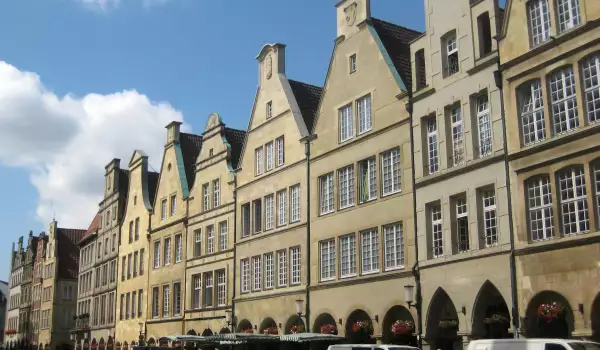Münster

Münster is located in north western Germany, on the North Rhine - Westphalia. It is considered one of the essential cultural and religious centres of the region. The beautiful river Aa passes through the town. The population is about 270 000 people.
Over the centuries, Münster had a significant role in the development of the country. There were signed contracts important to decide the future of Germany. Today the unique building of the Münster pean Catholic bishop, fine buildings and many bike lanes make Münster a tempting destination for thousands of tourists annually. Often, the city is called "the bicycle capital of Germany."
Although much of the city was destroyed during World War II, today the urban landscape is rather old. This is because local residents and architects have unanimously decided to restore the ancient buildings in their original form, instead of building modern buildings. Their initial decision was harshly criticized, but today the visitors admire locals for their brilliant performance of those intentions.
Münster was founded by the missionary Liudger back in 793. In fact, the city name, translated from German means "monastery". This is no accident. Münster houses the religious temple Lyudger that created on these lands.
The biggest landmark is St. Paul's Cathedral. This religious shrine was erected through the efforts of the founder of the city - Liudger. Architectural style of the cathedral is Romanesque and early Gothic. Unfortunately, much of the building was destroyed during the bombings of WW2. Efforts to restore its image were clearly successful. The cathedral is a great example of combining religion and astronomy. The temple has preserved an unique astronomical clock, dating back nearly five centuries, which consists of 12 painted astrological signs, which follow the movements of the planets.
The atmosphere of the city is complemented by the melodic sound that comes from the cathedral at 12 o'clock.
The church of St. Lambert is also one of the main attractions of Münster. However, it has an unusual exterior. The front facade of the temple has three steel cages in which were placed the corpses of the initiators and leaders of the Münster uprising. The separatists preached polygamy and abandoned their property.
Münster is one of the educational centers of Germany. Often called the "university city", this city has seven colleges, which teach about 50, 000 students. Only in the largest university, called Westfälische Wilhelms-Universität are taught about 42, 000 students. One of the administrative buildings of the university is called Schloss. The majestic building was erected in the second half of the 18th century. Its original purpose was to be the residence of the bishops, recognition is as Münster Catholic bishop. Today there is housed the administrative centre of the university.
The most popular street in Münster is called Prinzipalmarkt. Tall narrow buildings with their inherent sharp peaks create an unique atmosphere in the German town. Over the centuries, generations of entrepreneurs have set up and developed trades and crafts on this particular street. The oldest commercial street in Munster, founded in the 12th century, is the centre of "Old Town". The historical atmosphere is restored in all its glory after the bombing of 1943. In a Gothic building here, was actually signed the Peace Treaty of Westphalia, in 1648, which ended the Thirty Years War.
Another place you must visit is the Cultural History Museum and Natural History Museum. The Pablo Picasso Museum is another pride of the city. It has collected some of the best works of the legendary artist.
44 miles north of Münster is the town of Osnabrück. Nearby are Dortmund - 61 kilometers away and Bielefeld - 62 km away. The Dutch Enschede is located 60 km northwest of Münster.






